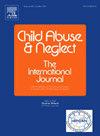The increase in online child sexual solicitation and abuse: Indicator 16.2.3 of the UN Sustainable Development Goals (SDG) documents a hidden and growing pandemic. Population-based surveys fail to capture the full picture
IF 3.4
2区 心理学
Q1 FAMILY STUDIES
引用次数: 0
Abstract
Background
The United Nations' Sustainable Development Goals (SDGs) call for systematic monitoring of the prevalence of sexual violence against children and young people. The rise of the internet has facilitated the risk of online child sexual solicitation and abuse (OCSSA), a critical issue that warrants particular attention and must not be overlooked.
Objective
This study examines the prevalence of OCSSA, distinguishing between online child sexual abuse (OCSA) and online sexual solicitation (OSS) in Germany, and explores generational differences.
Participants and setting
A representative German sample of 3098 participants aged 18–96 was assessed. The 18–29 age group was oversampled, and the results were weighted accordingly.
Method
Participants completed screening questions on OCSSA experiences. Descriptive statistics, Chi2-tests, and logistic regression were used to analyze age-related differences, controlling for socio-demographic and -economic factors.
Results
In the general population, 10.3 % reported experiencing at least one form of OCSSA, with 2.8 % reporting OCSA, and 9.3 % OSS. Among younger participants aged 18–29, prevalence was significantly higher at 31.6 % for OCSSA, 3.5 % for OCSA, and 29.6 % for OSS. The most common experiences among younger participants were exposure to pornographic material (21.1 %) and sexualized conversation (15.0 %). Age was the main predictor of OCSSA.
Conclusion
OCSSA is significantly more prevalent among younger generations in Germany, likely due to increased exposure to digital environments during childhood coupled with the proliferation of the internet and social media in recent decades. These findings highlight the urgent need for targeted prevention efforts addressing online risks.
网上儿童性引诱和性虐待的增加:联合国可持续发展目标指标16.2.3记录了一种隐藏的、日益严重的流行病。以人口为基础的调查未能全面反映情况
联合国可持续发展目标(sdg)呼吁系统监测针对儿童和青少年的性暴力的普遍性。互联网的兴起增加了网上儿童性引诱和性虐待(OCSSA)的风险,这是一个值得特别关注且不容忽视的关键问题。目的本研究考察德国在线儿童性虐待(OCSA)和网络性引诱(OSS)的流行程度,并探讨代际差异。参与者和环境对3098名年龄在18-96岁之间的德国代表性样本进行了评估。对18-29岁年龄组进行过采样,并对结果进行相应加权。方法被试完成OCSSA体验筛选题。采用描述性统计、chi2检验和逻辑回归分析年龄相关差异,控制社会人口统计学和经济因素。结果在普通人群中,10.3%的人报告经历过至少一种形式的OCSSA,其中2.8%为OCSA, 9.3%为OSS。在18-29岁的年轻参与者中,OCSSA的患病率明显更高,为31.6%,OCSA为3.5%,OSS为29.6%。年轻参与者中最常见的经历是接触色情材料(21.1%)和性对话(15.0%)。年龄是OCSSA的主要预测因子。结论:在德国,ocssa在年轻一代中更为普遍,这可能是由于儿童时期接触数字环境的增加,以及近几十年来互联网和社交媒体的普及。这些发现突出表明,迫切需要针对网络风险开展有针对性的预防工作。
本文章由计算机程序翻译,如有差异,请以英文原文为准。
求助全文
约1分钟内获得全文
求助全文
来源期刊

Child Abuse & Neglect
Multiple-
CiteScore
7.40
自引率
10.40%
发文量
397
期刊介绍:
Official Publication of the International Society for Prevention of Child Abuse and Neglect. Child Abuse & Neglect The International Journal, provides an international, multidisciplinary forum on all aspects of child abuse and neglect, with special emphasis on prevention and treatment; the scope extends further to all those aspects of life which either favor or hinder child development. While contributions will primarily be from the fields of psychology, psychiatry, social work, medicine, nursing, law enforcement, legislature, education, and anthropology, the Journal encourages the concerned lay individual and child-oriented advocate organizations to contribute.
 求助内容:
求助内容: 应助结果提醒方式:
应助结果提醒方式:


